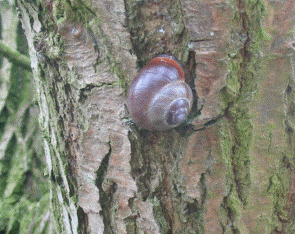Cepaea nemoralis Linnaeus,1758 One of the most common landsnails in Europe and maybe the world is Cepaea nemoralis.The shell is subglobose,a little glossy and has 4.5-5.5 whorls. The height is about 12-22 mm and width 18-25 mm.The colour can be very variable but has never more than 5 bands.The lip is dark,but sometimes white lipped forms occur. A lot of study has gone into the colour and banding of these snails. The body of the animal is greyish but lighter forms occur.The dart is 7-8 mm and is shaped like a star with four blades in cross section. Cepaea nemoralis can be found in very different habitats from humid ones like woods and marshes to drier places like sandhills and old walls. Besides distributed in Europe it also has been introduced in North-America.
Cepaea hortensis Muller,1744 This species is very similar to C.nemoralis but the shell is in general more globose and smaller.Also the colour is often yellow with a white lip, but as in C.nemoralis its very variable.The body of the animal is greenish grey. One of the most reliable determination factors is the love dart which is 4 mm long and looks a bit like a maltese cross in cross section. As with C.nemoralis the same formula for banding can be applied here. C.hortensis is common in Europe and can also be found in eastern North-America.It tends to occurs in colder and more humid places than C.nemoralis but both species also can be found together.
Colouring and banding
Much study has gone into the colouring and banding of this species.It is generally believed that the colour depends on the habitat
where the snails live.It is a form of adaptation which makes it harder for predators like the Song thrush to find the snail.
A study(Sheppard,1951)showed that in early spring snails with yellow coloured shells were caught more often than the darker coloured ones.
They were more easily visible on the dark background.Later in the spring when foliage made the background greener the
snails with the darker coloured shells were easier to prey on.

 The anvil of a Song-Thrush A typical woodland Cepaea nemoralis
The anvil of a Song-Thrush A typical woodland Cepaea nemoralis
Research showed that a lot of unbanded forms live in uniform environments like grasslands,dunes and woods.
The snails living in darker places tend to have darker shells as well,while the ones living in more sunny areas have lighter(yellow) shells
The banded forms appear in more diverse habitats like mixed hedgerows and shrubs.It also seems
to be connected with regulation of temperature,the lighter shells reflect light better in open places and the darker shells absorb warmth
quicker in dark spots.
The bodies of snails living in lighter(sunnier)habitats are often lighter too.And the bodies of snails living in darker,shadowy places,are darker as well.
This has also has to do with reflection of sunlight(limiting moisture loss) or absorbing the light(heating up more quickly).
Because C.nemoralis has never more than 5 bands a formula has been made up to count the bands.The bands are counted from
the apex of the shell downwards.A letter which stands for the colour of the shell starts the formula.Y for yellow,B for brown and R for red.
A yellow shell with all 5 bands has this formula:Y12345,so an unbanded form is Y00000.
What often happens is that 2 bands fuse together,in that case the formula would be like this:Y(12)345.
In other cases bands split,the formula then would be this:Y122345.
There used to be many varieties named,but nowadays this is hardly used anymore.For example: var.rubella for red shells,var.major for large
shells and var.libellula for yellow shells.